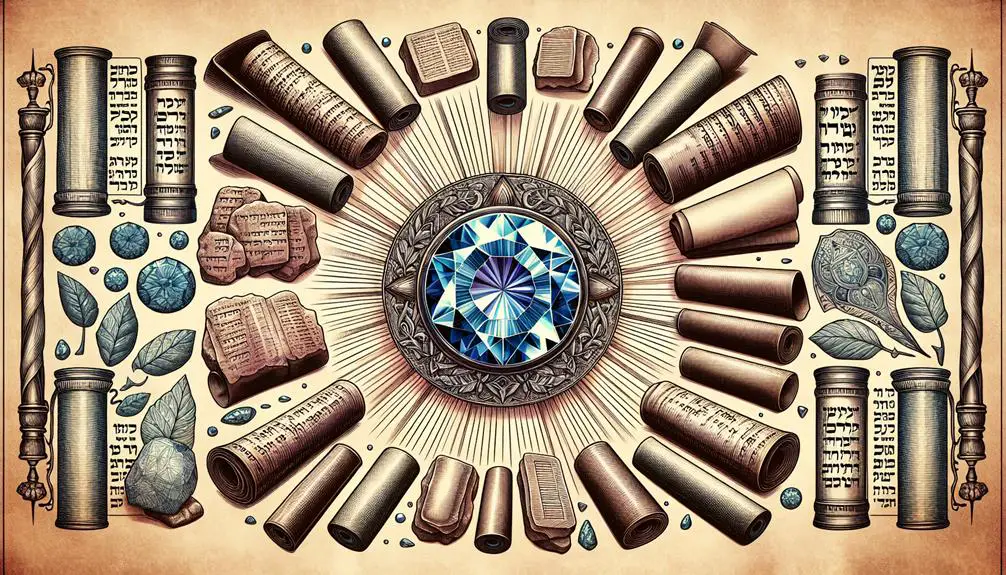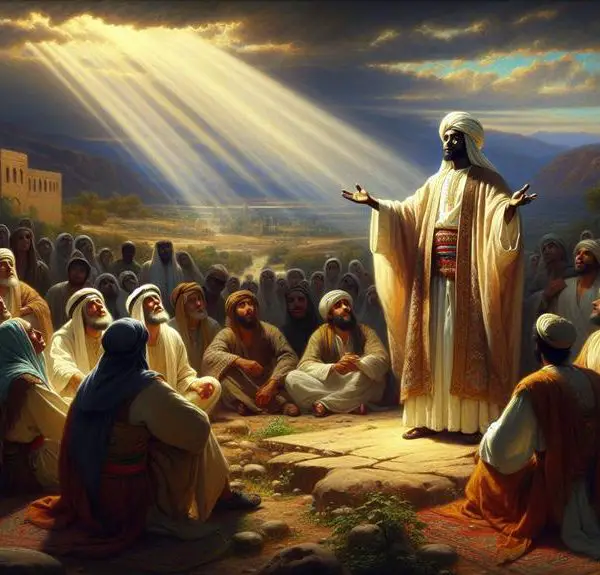Discover the captivating role of beryl in biblical narratives, a gem that bridges the divine with the material world.

Beryl in the Bible
Have you ever wondered why beryl, among all gemstones, holds a prominent place in biblical texts? This semi-precious stone isn't just mentioned; it's woven into the fabric of several key biblical narratives. From adorning the Breastplate of Aaron to symbolizing divine glory in the visions of Ezekiel and John's apocalyptic revelations, beryl's significance is multi-layered.
It's not merely its physical beauty that merits attention but the rich symbolism and meanings attributed to it in religious contexts. As we explore its role, you'll find that beryl's inclusion in these ancient texts offers a fascinating glimpse into how spirituality and materiality intersect in the quest to represent the divine.
Key Takeaways
- Beryl symbolizes divine guidance and spiritual leadership, as seen in its inclusion in the Breastplate of Aaron.
- It is associated with divine clarity and purity in Ezekiel's visionary descriptions.
- In the Book of Revelation, beryl enriches apocalyptic visions with its varied colors and symbolism.
- Beryl's spiritual interpretations connect it to divine beauty, power, and balance in both ancient and modern contexts.
The Significance of Gemstones

Gemstones frequently hold profound symbolic significance in various cultures, often reflecting societal values, beliefs, and historical narratives. As you delve deeper, you'll find that beyond their aesthetic allure, gemstones like beryl have been attributed with various healing properties and modern uses, bridging the gap between the ancient and the contemporary.
In the realm of modern uses, beryl, a mineral comprising several gem varieties including aquamarine and emerald, plays a pivotal role. Its unique properties aren't only prized in jewelry making but also in technological applications, such as precision optical instruments. This versatility underscores the evolving significance of gemstones from purely decorative to functional roles in society.
Moreover, the healing properties associated with beryl are a testament to the enduring belief in the metaphysical power of gemstones. Traditionally, beryl has been believed to promote courage, relieve stress, and enhance communication skills. These attributes align with the broader contemporary interest in holistic health and wellness, where gemstones are integrated into practices aimed at achieving physical, emotional, and spiritual balance.
Analyzing the significance of gemstones like beryl reveals a multifaceted narrative. It's not merely about their inherent beauty or value but also about their capacity to embody and transmit cultural, spiritual, and now, functional values across generations. This intricate interplay between the past and present, between tradition and innovation, highlights the enduring fascination with and relevance of gemstones in human culture.
Beryl in Ancient Texts

You'll find that beryl holds a notable position within ancient texts, revealing its cultural and spiritual significance across various civilizations.
The biblical references to beryl not only emphasize its value but also offer insights into its perceived properties and symbolism during ancient times.
Analyzing these descriptions provides a deeper understanding of how ancient societies viewed and utilized this gemstone in their religious and daily lives.
Beryl's Biblical Significance
Beryl's significance in biblical texts, notably its frequent mentions, reflects its esteemed status among ancient civilizations. This gemstone's origins and the way modern interpretations have evolved reveal a rich history interwoven with spiritual and cultural values.
Consider these points:
- Beryl's Origins: Initially discovered in regions like the Red Sea islands, its rarity contributed to its value and symbolic meanings.
- Modern Interpretations: Today, scholars and theologians ponder beryl's implications in biblical narratives, often linking it to concepts of clarity and divine wisdom.
- Biblical Context: Its mention alongside other precious stones in sacred texts underscores its importance in religious rituals and as a symbol of beauty and power.
Analyzing beryl within these frameworks offers insights into its enduring legacy and the timeless nature of its allure.
Ancient Descriptions of Beryl
Exploring ancient texts reveals that beryl, a gemstone of significant esteem, was frequently described with reverence, highlighting its symbolic and literal brilliance in early civilizations.
You'll find its geological formation often intertwined with its perceived virtues, suggesting a deep connection between the earth's processes and the gemstone's value to ancient societies.
These texts meticulously detail the conditions under which beryl forms, emphasizing its rarity and the awe it inspired. Moreover, references to its contemporary uses, though millennia old, mirror today's appreciation for beryl's beauty and durability.
Scholars meticulously analyze these ancient descriptions, drawing parallels between past and present, underscoring the timeless allure of beryl. This scholarly approach not only enriches our understanding of beryl's historical significance but also enhances our appreciation for its enduring legacy.
The Breastplate of Aaron

Within the context of ancient biblical artifacts, the Breastplate of Aaron stands out due to its intricate design and the inclusion of twelve precious stones, among which beryl is notably featured. This ceremonial piece, central to Aaron's attire, symbolizes the connection between divine guidance and the twelve tribes of Israel. The crafting of this breastplate, especially its incorporation of beryl, reflects a high level of gemstone crafting expertise, indicative of the period's sophisticated artisanship.
To understand the significance of the breastplate, consider the following points:
- Symbolism: Each stone on the breastplate represents one of the twelve tribes of Israel, serving as a constant reminder of Aaron's responsibilities towards them. Beryl, in particular, is thought to symbolize lightness and balance, characteristics essential for spiritual leaders.
- Communication with the Divine: The breastplate was believed to be a medium through which God communicated His will to the Israelites, especially in matters of judgment and community guidance. This underscores the importance of each gemstone, including beryl, in facilitating this divine connection.
- Craftsmanship and Material Value: The selection of beryl, along with other precious stones, for Aaron's breastplate underscores the value placed on beauty and durability in sacred objects. The meticulous crafting process reflects the reverence with which these items were regarded, serving both a spiritual and aesthetic purpose.
Ezekiel's Visionary Descriptions

Moving from the tangible artistry of Aaron's breastplate, we now examine the ethereal imagery in Ezekiel's visionary descriptions, where the use of gemstones, including beryl, continues to underscore profound spiritual themes. Ezekiel's text is a canvas, rich with prophetic imagery and visionary precision, painting a picture far beyond the mere physical attributes of the stones themselves.
You'll find that Ezekiel's visions are steeped in a symbolism that's both intricate and profound. The mention of beryl within these visions isn't mere adornment but serves as a metaphorical bridge connecting divine presence and revelation. This use of beryl, among other gemstones, aids in the visualization of concepts that are otherwise abstract and ethereal, grounding them in a reality familiar to the reader yet elevated to a plane of spiritual significance.
The prophetic imagery in Ezekiel employs beryl to depict not just beauty or value but to evoke a sense of divine clarity and purity. Through Ezekiel's visionary precision, beryl becomes a symbol of the ineffable, a tangible representation of the divine that's both accessible and impenetrably mysterious. This strategic incorporation of gemstones, including beryl, serves a dual purpose: it enriches the text's visual imagery and deepens its spiritual resonance, offering you a glimpse into the celestial through the earthly.
In analyzing this, it's essential to appreciate the layered significance of these references. Ezekiel's use of beryl transcends mere decoration, embodying themes of divine revelation, judgment, and the transcendental nature of prophetic visions. Through this lens, the prophetic texts invite a deeper reflection on the interplay between the material and the spiritual, challenging you to see beyond the surface to the profound truths underlying the prophetic imagery.
Beryl in the Book of Revelation

Delving into the Book of Revelation, you'll discover beryl not as a mere decorative element but as a profound symbol woven into the very fabric of apocalyptic visions and divine promises. This gemstone's presence amidst Revelation's imagery speaks volumes, inviting a deeper exploration of its role and significance in the biblical text.
When analyzing beryl within the context of Revelation, three key aspects stand out:
- Gemstone Identification: Beryl, known for its varied colors from green to blue-green, aligns with the ancient practice of using gemstones to signify particular truths or realities. Its identification among the stones in Revelation is crucial, highlighting its importance alongside other gems in the biblical narrative.
- Descriptive Role in Apocalyptic Imagery: The use of beryl in Revelation isn't arbitrary. Its inclusion serves a specific purpose in the descriptive landscape of John's vision, adding layers to the vivid and symbolic universe depicted. The imagery of beryl, alongside other stones, contributes to a rich tapestry that invites readers to contemplate the celestial and divine.
- Contextual Interpretation: Understanding beryl's role requires delving into historical, cultural, and theological contexts. Its presence is a nod to the gemstone's perceived value and symbolism in ancient times, enriching the interpretation of Revelation's complex and multifaceted visions.
Symbolism and Meanings

You'll find that beryl's significance in biblical texts extends far beyond its physical appearance, embodying divine representation and spiritual interpretations.
This gemstone's inclusion in sacred narratives suggests a multifaceted symbolism, reflecting not only theological virtues but also eschatological themes.
Beryl's Divine Representation
In biblical texts, beryl often symbolizes divine wisdom and eternity, reflecting its significant spiritual and theological implications. When exploring beryl's divine representation, it's crucial to consider its physical characteristics, which are deeply intertwined with its symbolic meanings:
- Mineral Formation: Beryl's crystalline structure and the conditions under which it forms are emblematic of the divine craftsmanship and the intricate design of the universe.
- Geographic Origins: The locations where beryl is found, often remote and requiring significant effort to extract, mirror the pursuit of spiritual enlightenment and the journey one undertakes to gain divine wisdom.
- Physical Appearance: The gemstone's transparency and range of colors symbolize purity, a spectrum of divine qualities, and the complexity of understanding the divine.
These aspects collectively highlight beryl's role as a symbol of divine wisdom and the eternal pursuit of understanding the divine realm.
Spiritual Interpretations
Exploring the spiritual interpretations of beryl, we uncover its multifaceted symbolism and deeper meanings that have resonated through ancient texts and traditions.
Aspect |
Ancient Interpretation |
Modern Interpretations |
|---|---|---|
Symbolism |
Divine beauty and power |
Balance and harmony |
Healing Properties |
Physical and spiritual healing |
Emotional balance and clarity |
Deeper Meanings |
Connection to the divine |
Personal growth and enlightenment |
Analytically, beryl's healing properties were once revered for their capacity to both physically and spiritually mend, a belief that persists in modern interpretations, emphasizing emotional balance and mental clarity. The transition from ancient to contemporary views reflects a deeper, evolving understanding of beryl's significance, bridging divine connection with personal growth and enlightenment, thus illustrating its enduring spiritual impact.
Divine Glory and Beauty

Beryl, as depicted in biblical texts, symbolizes divine glory and beauty, reflecting a profound spiritual significance embedded within its use and descriptions. This gemstone, often gleaming with a heavenly light, serves not only as a physical adornment but also as a metaphor for purity and the divine. Its presence in sacred scriptures isn't merely ornamental; it carries with it layers of meaning that resonate through ages, touching upon the divine essence itself.
When we delve into the implications of beryl's representation of divine glory and beauty, a few key points stand out:
- Symbolic Representation: Beryl's clear, radiant appearance in biblical contexts often symbolizes the unblemished and pure nature of the divine. Its translucence and beauty are seen as reflective of the glory and perfection of the heavens, suggesting an unbreakable connection between the divine and the material world.
- Crystal Healing and Modern Interpretations: In contemporary times, beryl's biblical significance has been reinterpreted through the lens of crystal healing and spiritual practices. Its association with divine beauty is thought to extend to the realm of personal enlightenment and spiritual growth, offering a bridge between ancient wisdom and modern spiritual quests.
- Artistic and Literary Inspiration: The biblical depiction of beryl has inspired countless works of art and literature, emphasizing its role in representing divine beauty. Artists and writers have drawn upon its symbolic value to convey messages of purity, divinity, and the transcendent nature of beauty itself.
Through these aspects, beryl's representation in the Bible as a symbol of divine glory and beauty is rich with meaning, offering insights into the spiritual and aesthetic values of ancient times and influencing modern interpretations and practices.
Beryl's Role in Religious Contexts

Delving into religious contexts reveals that beryl's significance extends beyond mere adornment, embodying a profound spiritual and liturgical role across various traditions. This gemstone's geological origins, emerging from the depths of the earth, symbolize a tangible connection between the divine and the terrestrial. As you explore its presence in sacred texts, beryl isn't just a mineral; it's a vessel of divine light and wisdom, chosen for its purity and brilliance to represent celestial virtues.
Modern interpretations of religious texts often highlight beryl's symbolic resonance, underscoring its role in conveying messages of purity, enlightenment, and divine favor. Scholars meticulously dissect passages to understand how beryl's physical attributes were perceived as manifestations of spiritual ideals. For instance, in its biblical appearances, beryl is frequently associated with visions of heavenly realms, suggesting a link between its ethereal beauty and divine revelation.
This interpretative journey through religious symbolism shows you that beryl's value isn't solely measured by its physical properties but also by its capacity to inspire and elevate human spirit. Its enduring presence in religious artifacts and texts points to a deeper, metaphysical significance—beryl serves as a reminder of the transcendent, bridging the gap between humanity and the divine.
Frequently Asked Questions
How Does the Interpretation of Beryl's Symbolism Differ Among Various Christian Denominations?
When you dive into the symbolism of beryl, you'll find its interpretation varies among Christian denominations due to its origins and use in denominational rituals.
Some see it as a symbol of purity and glory, reflecting divine presence, while others may interpret it more as a representation of spiritual wealth.
This diversity stems from how each tradition views biblical references and integrates them into their teachings and practices.
It's a fascinating study in theological perspectives.
Are There Any Notable Historical Artifacts, Aside From Those Mentioned in the Bible, Where Beryl Has Been Prominently Featured Due to Its Biblical Significance?
You're exploring beryl's journey from ancient artifacts to modern uses, setting aside its biblical roots.
The etymology of beryl reveals a tale of transitions, from sacred to secular.
Historically, notable artifacts feature beryl for its beauty and supposed properties, not just its scriptural significance.
Analyzing these pieces, you'll find beryl in royal regalia and ancient treasures, showcasing its enduring appeal.
This evolution reflects beryl's shift from a sacred stone to a versatile modern gem.
How Have Modern Gemologists or Mineralogists Contributed to Our Understanding of the Beryl Mentioned in Biblical Texts, Especially in Distinguishing It From Similar Gemstones?
You're diving into how modern gemologists have enhanced our understanding of beryl, focusing on gemstone identification and color variation. They've used advanced techniques to distinguish beryl from similar stones, considering its wide color range.
This meticulous work is crucial for accurately classifying beryl types, ensuring historical artifacts are correctly identified. Their contributions offer a deeper insight into the gemstone's properties, making it easier to recognize and appreciate its significance across various contexts.
In Terms of Biblical Archaeology, Have There Been Any Significant Discoveries of Beryl That Help Corroborate Its Use or Value in Ancient Biblical Times?
You're diving into a world where modern mining meets ancient treasures. When it comes to beryl identification, archaeologists have made strides. They've unearthed artifacts and sites where beryl's presence underscores its historical significance.
These discoveries not only align with ancient texts but also highlight beryl's valued role. Through meticulous excavation and analysis, the evidence solidifies beryl's esteemed place in antiquity, offering a tangible link to the past's opulent customs and practices.
How Has the Depiction of Beryl in Biblical Art Evolved Over the Centuries, Particularly in Christian Iconography and Religious Manuscripts?
You've likely noticed beryl's depiction in art has evolved significantly, embracing various color interpretations and artistic techniques.
Initially, its portrayal might've been straightforward, but over centuries, artists have delved deeper, using beryl's hues to convey complex theological themes.
This evolution in Christian iconography and religious manuscripts reflects a growing understanding and appreciation of the gem's symbolic potential, showcasing an intricate blend of artistry and religious symbolism that enriches our cultural heritage.
Conclusion
In your journey through the scriptures, beryl isn't just a gemstone; it's a beacon of divine splendor and wisdom. Its presence in the Breastplate of Aaron, Ezekiel's visions, and the apocalyptic beauty of Revelation isn't mere adornment.
Like a lighthouse guiding ships through treacherous waters, beryl illuminates your path to understanding the profound, multifaceted nature of divinity. It's a testament to the intricate ways in which the sacred intersects with the tangible, elevating our perception of spiritual truths.



Sign up